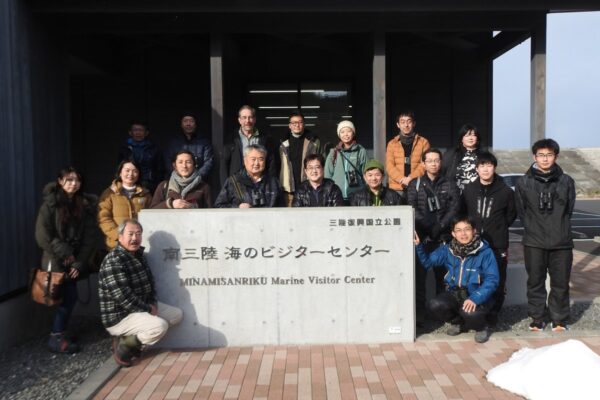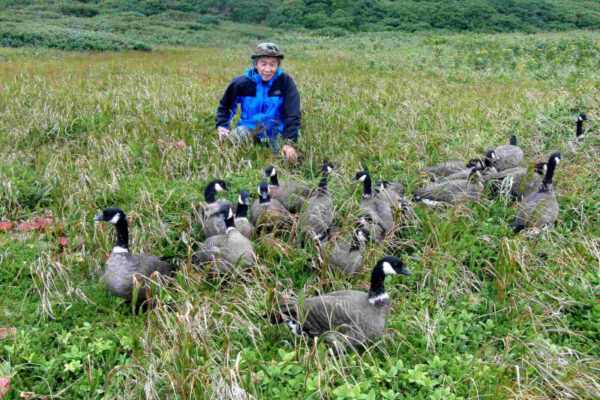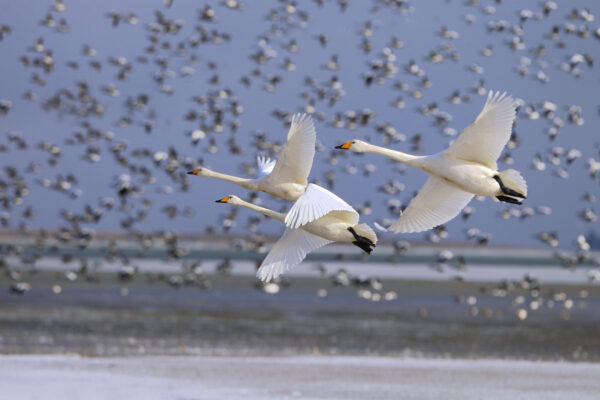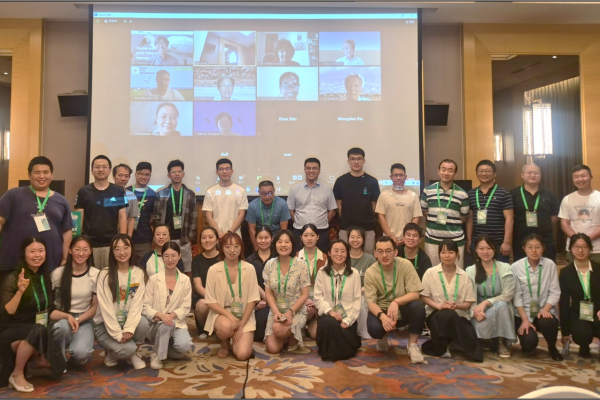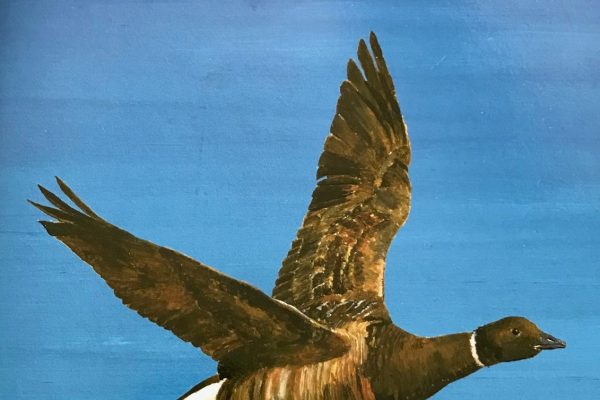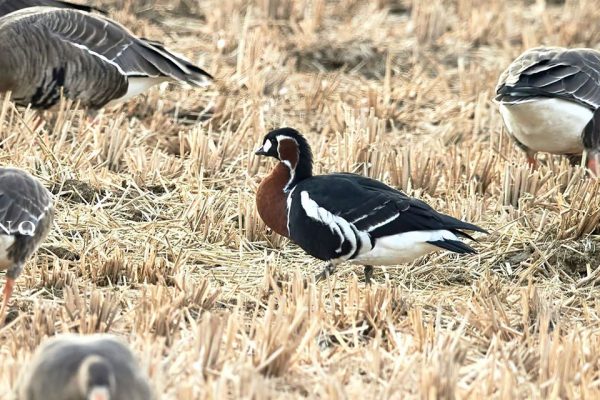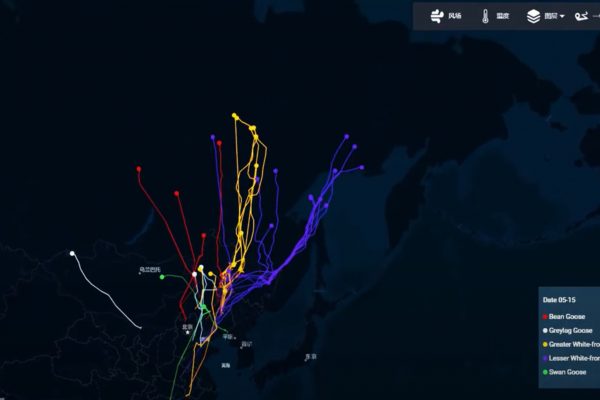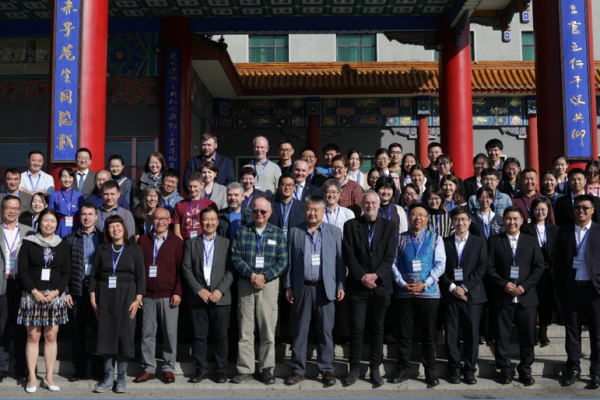-
International Workshop on Geese Conservation and Management in East Asia
Group photo © Katsumi Ushiyama/Japanese Committee of the Anatidae Working Group On 27 – 29th January, 2023, the Japanese Committee of Science and Technology of the Anatidae Working Group hosted the “International Workshop on Geese Conservation and Management in East Asia” with the support of The Miyagi Prefectural Izunuma-Uchinuma Environmental Foundation. The three-day workshop included experts’ meeting, an open symposium and an excursion. Dr. David Ward of USGS Alaska, Dr. Hansoo Lee of KoEco, Dr. Cao Lei of Research Center for Eco-Environmental Sciences, Chinese Academy of Sciences, were invited as international experts. The experts’ meeting started with an information-sharing session on the situation of geese conservation and management of each country, particularly on responsible organizations, protective status, population trends, monitoring and research. Nextly, Yusuke Sawa of Yamashina Institute of Ornithology reported the progress of the Brent geese action plan and recent tracking studies performed in Japan. The meeting was concluded with a fruitful discussion on finding research gaps, management framework and future actions for advancing geese conservation and management in East Asia. The symposium, live streamed and archived in YouTube , started with a plenary lecture from Dr. David Ward titled “Population Trends and Conservation of Geese in the Eastern Pacific Flyway” with recommendations for evidence-based conservation and management in the East Asian region. In the following session on “Geese of Japan”, Mr. Masayuki Kurechi of Japanese Association for Wild Geese Protection reported the achievements on the recovering cackling geese and snow geese, Dr. Tetsuo Shimada of The Miyagi Prefectural Izunuma-Uchinuma Environmental Foundation reported the issues concerning the abundant greater white-fronted goose, and Mr. Yusuke Sawa reported the recent progress of the geese tracking project in Japan. The next session was on “Geese in East Asia”, where Dr. Hansoo Lee introduced the outcomes of the nationwide water bird census and international cooperative research works for tracking migratory geese. Dr. Cao Lei introduced the status of 5 geese species in China, emphasizing the need to protect the Yangtze lakes, especially Poyang and Dongting Lake and their hydrological progress. © Katsumi Ushiyama/Japanese Committee of the Anatidae Working Group The symposium closed with a panel discussion building up on the conversation in the experts’ meeting. One of the main conclusion was to make a comprehensive international plan which can share goals, roles and principles for geese conservation and management in the East Asian region, as in the North American Waterfowl Management Plan. The major gaps to fill in for effective management were: 1) coordinated monitoring and analysis of population parameters, such as the survival rate based on banding survey and reproductive rate based on juvenile ratio monitoring 2) data sharing on tracking studies; 3) natural habitat conservation for declining specialist species, and 4) agricultural habitat management for increasing generalist species. To establish methods for evidence-based management of East Asian geese populations, the greater white-fronted goose was chosen as a model species for population modeling. The final day of the workshop was a field trip to three Ramsar sites, Izunuma, Kabukurinuma, Shizugawa-wan. The three-day workshop was funded by the Keidanren Nature Conservation Fund, Japan Fund for Global Environment, and Tsudo Fund of the Ornithological Society of Japan. Morning flight of geese in Izunuma © Katsumi Ushiyama/Japanese Committee of the Anatidae Working Group Rewatch the Symposium on Youtube: Prepared by Katsumi Ushiyama, Coordinator of Anatidae Working Group
Continue reading -
“Flyway: Connecting People and Migratory Waterbirds” Story Series #17 – Interview with Mr. Masayuki Kurechi, awardee of Eighth edition of Ramsar Wetland Conservation Awards
In this issue of Flyway story, we invited Mr. Masayuki Kurechi, Board Member of Ramsar Network…
Continue reading -
Rongcheng Swan National Nature Reserve in China became Flyway Network Site on World Wetlands Day 2022
On 2nd February, 2022 World Wetlands Day, the EAAFP and its Partners celebrate Rongcheng Swan National Nature Reserve in the People’s Republic of China as the new Flyway Network…
Continue reading -
Anatidae WG organized Symposium in the 9th EAFES International Congress in Hohhot, China
The 9th EAFES International Congress was held in Hohhot, Inner Mongolia, China, from 10-13th July 2021, hosted by the East Asian Federation of Ecological Societies (EAFES), with eight symposiums included. The symposium 04 was organized by the Anatidae Working Group (AWG) and Research Center for Eco-Environmental Sciences, Chinese Academy of Sciences (RCEES, CAS), entitled with “Recent telemetry technology helps waterbird and wetland conservation in East Asia”. Professor Lei CAO of RCEES is the Principal organizer of symposium 04, co-organized by the Chair Masayuki KURECHI and the coordinator Katsumi USHIYAMA of the AWG, and Dr. Hansoo LEE from Korea Institute of Environmental Ecology. This has been an exhilarating online meeting and we can all be deeply grateful to old friends and new friends for contributing an inspiring program of excellent talks. We are so grateful to everybody for helping to overcome the challenges of not being able to be together but to continue to build our collaborations through the internet. The symposium 04 aimed to think about how to work together to save waterbirds and wetlands for our next generation, including 4 sections and 29 oral reports. 4 sections are included: Waterbird monitoring and population trends, Recent research on Common waterbird species, Recent research on globally threatened waterbird species, Waterbird and wetland conservation. A number of highlights from the meeting have emerged. The first is the need for continued long-term monitoring of waterbird abundance on breeding, staging and wintering areas to monitor the state of the populations (mainly in winter when most aggregated) but also at other times of year. This is essential to check the quality of our protected areas and effects of positive and adverse management activities to better understand how to protect sites and the waterbirds that use them. The extraordinary value of combining tracking studies with site protection. Telemetry has revealed discrete biogeographical populations, but also shown links between disease and these migration routes and identified new important key sites but also taught us much about how birds use the protected site and their networks. As we have seen with the rare species such as the Swan Goose and Black-faced Spoonbill, and vulnerable subspecies Tibetan Common Crane, we need to increasingly combine these sources of knowledge if we are going to identify the key factors affecting their abundance and make sure we create adequate areas of sufficient quality to protect our waterbirds for future generations. We also heard how the description of flyway routes can aid with spatial planning, especially with regard to the location of wind turbines, which is crucial in case of Japan, where offshore big wind farms are planned along Japan Sea coast. In Akita prefecture and other northern part of Honshu Island, thousands of big wind turbines (maximum 260 m high) are on the way to be built along the sea coast about 1-3km off the coast. That is likely to affect many waterbirds (swans, geese, ducks and other sea birds) of this flyway especially during migration. We are much concerned about the expected damage on waterbirds and feel the need to establish a guideline to avoid such damages. We need to be better at seeing adverse trends earlier, the worrying declines in the Aythya duck in Japan show that the common species of today can become the rare species of tomorrow if we do not generate populations’ trends and act to find the reasons for their unfavorable conservation status. It also reminds of the need to develop more demographic monitoring, including sampling sex and age ratios, to estimate per capita reproductive success and survival so that we can interpret observed changes in population size. It is vital we know if populations are declining because of poor reproductive success and/or increasing mortality so we can investigate why. Kurechi-San also reminded us of the value of recovery and restoration to supplement our research and conservation efforts to rescue species. He also reminded us of the tragic loss this year of Prof Andreev, who was such a knowledgeable giant of waterbird ecology in our flyway. Wind farms as an emerging threat for waterbirds, and the need to provide evidence-based solutions for such threats. The Liaohe River study reminds us of the continued loss of habitat in the face of development and the continued need to be vigilant, but also reminds us of the importance of gathering scientific data to fight for the protection of our globally important waterbird populations. Most of all, we see the increasing benefit of countries and researchers working together to the benefit of our waterbirds. It is so exciting and encouraging to see the strengthening links and bonds between all the countries along the East Asian flyway to the benefit of our shared waterbirds, reflected in the work of the Crane Working Group of Eurasia, but also in the multinational authorship of the all talks we have heard the last two days. We still have no idea about Brent Goose flyways and the true status of this species in our region, yet researchers in six countries are doing their best to plug this gap. This type of collaboration is vital if we are going to see more success stories like those of Oriental Stork, Black-faced Spoonbill, and Crested Ibis about which we have heard. Such successes were unthinkable a few years ago, yet they are real achievements today. Let us make sure we do not let down the waterbirds tomorrow by ensuring the continued fruitful collaboration we have celebrated at this meeting the last two days. We definitely need more public support to mainstream conservation of waterbirds and wetlands in Asia, and waterbird research will have an important role by unraveling the amazing lives of the birds and revealing serious threats that is happening right near us. We could share various local problems for conservation of waterbirds. Those situations might be already resolved in some area, and going to be experienced other area in near future. In order to moving forward waterbird conservation in Asia, we can more cooperate with each other. Many thanks again to the organizers of a very productive symposium covering so much information. The discussion will be carried on in different working group, Such as the AWG (Anatidae Working Group), and every suggestion and help will be welcomed. ⓒ Research Center for Eco-Environmental Sciences, Chinese Academy of Sciences, July 2021 To learn more about 9th EAFES International Congress, click [here]. *The article was prepared by the Anatidae Working Group.
Continue reading -
Introduction of the picture book “Explore the mystery of the Brent Goose”
Written by Yusuke Sawa from Yamashina Institute for Ornithology Brent Geese Branta bernicla_breed…
Continue reading -
First record of Red-breasted Goose Branta ruficollis in Japan
Reported by Tetsuo SHIMADA, Hiromi KANO & Toshihiro HOSOI We report the first record of Red-breasted Goose in Japan. The goose was observed in rice paddy fields (38°42’N,…
Continue reading -
Revealing migration patterns of five goose species in the East Asian-Australasian Flyway
Among the nine global flyways, the East Asian-Australasian Flyway (EAAF) is the most threatened one. Over 15% of the migratory waterbirds are threatened. In particular to some geese species…
Continue reading -
Anatidae Working Group
Anatidae Working Group The Working Group for the Anatidae Site Network in the East Asian Flyway was established in May 1999 to oversee the implementation of Action Plan for the Conservation of Migratory Anatidae in the East Asian Flyway under the Asia Pacific Migratory Waterbird Conservation Strategy. This working group then took on the role of supporting of the Partnership. The goal of the Anatidae Working Group is to coordinate, facilitate and promote collaboration on Anatidae conservation, management, education and research activities, across the East Asian-Australasian Flyway. Taxonomic groups in the Flyway include: Anatidae Ducks Geese Swans Working Group documentation All files are in pdf format. Download the Adobe Acrobat reader. Terms of Reference (Jan 2008) Working Group Chair Masayuki Kurechi Japanese Association for Wild Goose Protection Minamimachi 16, Kawaminami, Wakayanagi City, Miyagi, 989-5502 Japan Tel: +81-228-32-2004 E-mail: gan.g.kurechi@gmail.com Working Group Coordinator Katsumi Ushiyama Miyajimanuma Waterbird & Wetland Center Oomagari 3, Nishibibai, Bibai City, Hokkaido, 072-0057, Japan Tel: +81-126-66-5066, Fax: +81-126-66-5067 E-mail: mwwc@dune.ocn.ne.jp Bio: Katsumi Ushiyama, Ph. D. is a wetland manager and wildlife biologist at the Miyajimanuma Waterbird Wetlands Center, Japan. His specialty is conservation biology and behavioral ecology and has been involved especially in Greater white-fronted geese since 1997. His interests also include wetland restoration, wetland CEPA, and wetland culture. He is the secretary general of the Japan Wetlands Society, advisor of the Waterfowl Population Census of Japan, program committee member of the Ornithological Society of Japan and joins the Japan Ornithologist Group for Anatidae site network (JOGA). Useful Documents All files are in pdf format. Download the Adobe Acrobat reader. IUCN SCC Swan Specialist Group: Newsletter (Apr 2004) Publication Tracking swans in the East Asian flyway (2021) News about Anatidae in EAAF “Flyway: Connecting People and Migratory Waterbirds” Story Series #17 – Interview with Mr. Masayuki Kurechi, awardee of Eighth edition of Ramsar Wetland Conservation Awards Citizen Scientists in Republic of Korea Monitor Birds in River and Streams Rongcheng Swan National Nature Reserve in China became Flyway Network Site on World Wetlands Day 2022 Anatidae WG organized Symposium in the 9th EAFES International Congress in Hohhot, China Literature list (January-March 2021) Literature list (October-December 2020) EAAFP Secretariat visited Ulsan City in RO Korea Literature list (July-September, 2020) Introduction of the picture book “Explore the mystery of the Brent Goose” First record of Red-breasted Goose Branta ruficollis in Japan
Continue reading -
EAAFP pre-MOP9 meeting: Anatidae WG, Baer’s Pochard TF and Scaly-sided Merganser TF
A meeting focused on the Anatidae Working Group, Baer’s Pochard Task Force and Scaly-sided Merganser Task Force prior to the
Continue reading
- 1
- 2

